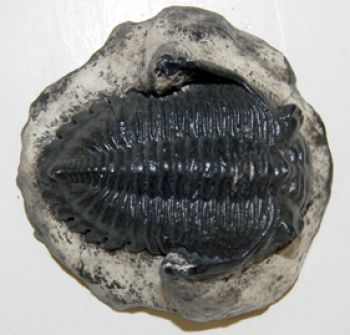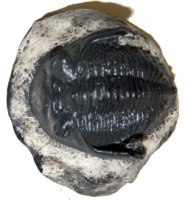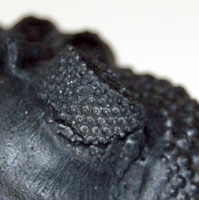
This large trilobite has great detail, especially the eyes. This specimen is from the Devonian of Morocco.
Trilobites are very well-known, and possibly the second-most famous fossil group after the dinosaurs with some 15,000 known species. Trilobites are extinct arthropods that form the class Trilobita. They appeared at the start of the Cambrian period and flourished throughout the lower Paleozoic era before beginning a drawn-out decline to extinction when the last of the trilobites disappeared in the mass extinction at the end of the Permian 250 million years ago (m.y.a.). The trilobite body is divided into three major sections, a cephalon with eyes, mouthparts and sensory organs such as antennae, a thorax of multiple similar segments (that in some species allowed enrollment), and a pygidium, or tail section. The name "trilobite" (meaning "three-lobed") is not based on the body sections cephalon, thorax and pygidium, but rather on the three longitudinal lobes: a central axial lobe, and two symmetrical pleural lobes that flank the axis. Trilobites range in length from one millimeter to 72 cm (1/25 inch to 28 inches), with a typical size range of two to seven centimeters (1 to 3� inches). The world's largest trilobite, Isotelus rex, was found in 1998 by Canadian scientists in Ordovician rocks on the shores of Hudson Bay. For more information see http://en.wikipedia.org/wiki/Trilobite.
solid resin
2.5 inches long
Item 456
Category: Replicas
Type: Skeletons
Phylum: Invertebrates
Class: Trilobites
MORE PHOTOS:



Now Over 1,000 Items!
PrehistoricStore.com offers the largest selection of replica fossils and other fossil-related products anywhere in the world!
Download a Full Catalog (3MB PDF)
OVER 260 PAGES OF REPLICAS AND MORE!
